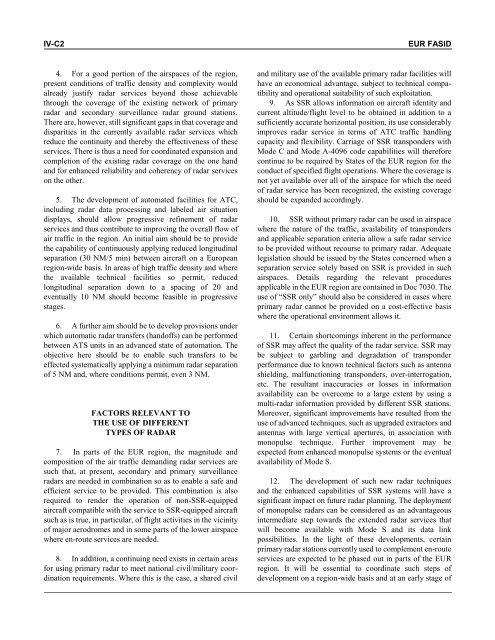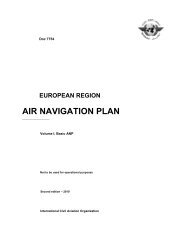7754 Vol 2 Flyleaf - ICAO Public Maps
7754 Vol 2 Flyleaf - ICAO Public Maps
7754 Vol 2 Flyleaf - ICAO Public Maps
You also want an ePaper? Increase the reach of your titles
YUMPU automatically turns print PDFs into web optimized ePapers that Google loves.
IV-C2<br />
EUR FASID<br />
4. For a good portion of the airspaces of the region,<br />
present conditions of traffic density and complexity would<br />
already justify radar services beyond those achievable<br />
through the coverage of the existing network of primary<br />
radar and secondary surveillance radar ground stations.<br />
There are, however, still significant gaps in that coverage and<br />
disparities in the currently available radar services which<br />
reduce the continuity and thereby the effectiveness of these<br />
services. There is thus a need for coordinated expansion and<br />
completion of the existing radar coverage on the one hand<br />
and for enhanced reliability and coherency of radar services<br />
on the other.<br />
5. The development of automated facilities for ATC,<br />
including radar data processing and labeled air situation<br />
displays, should allow progressive refinement of radar<br />
services and thus contribute to improving the overall flow of<br />
air traffic in the region. An initial aim should be to provide<br />
the capability of continuously applying reduced longitudinal<br />
separation (30 NM/5 min) between aircraft on a European<br />
region-wide basis. In areas of high traffic density and where<br />
the available technical facilities so permit, reduced<br />
longitudinal separation down to a spacing of 20 and<br />
eventually 10 NM should become feasible in progressive<br />
stages.<br />
6. A further aim should be to develop provisions under<br />
which automatic radar transfers (handoffs) can be performed<br />
between ATS units in an advanced state of automation. The<br />
objective here should be to enable such transfers to be<br />
effected systematically applying a minimum radar separation<br />
of 5 NM and, where conditions permit, even 3 NM.<br />
FACTORS RELEVANT TO<br />
THE USE OF DIFFERENT<br />
TYPES OF RADAR<br />
7. In parts of the EUR region, the magnitude and<br />
composition of the air traffic demanding radar services are<br />
such that, at present, secondary and primary surveillance<br />
radars are needed in combination so as to enable a safe and<br />
efficient service to be provided. This combination is also<br />
required to render the operation of non-SSR-equipped<br />
aircraft compatible with the service to SSR-equipped aircraft<br />
such as is true, in particular, of flight activities in the vicinity<br />
of major aerodromes and in some parts of the lower airspace<br />
where en-route services are needed.<br />
8. In addition, a continuing need exists in certain areas<br />
for using primary radar to meet national civil/military coordination<br />
requirements. Where this is the case, a shared civil<br />
and military use of the available primary radar facilities will<br />
have an economical advantage, subject to technical compatibility<br />
and operational suitability of such exploitation.<br />
9. As SSR allows information on aircraft identity and<br />
current altitude/flight level to be obtained in addition to a<br />
sufficiently accurate horizontal position, its use considerably<br />
improves radar service in terms of ATC traffic handling<br />
capacity and flexibility. Carriage of SSR transponders with<br />
Mode C and Mode A-4096 code capabilities will therefore<br />
continue to be required by States of the EUR region for the<br />
conduct of specified flight operations. Where the coverage is<br />
not yet available over all of the airspace for which the need<br />
of radar service has been recognized, the existing coverage<br />
should be expanded accordingly.<br />
10. SSR without primary radar can be used in airspace<br />
where the nature of the traffic, availability of transponders<br />
and applicable separation criteria allow a safe radar service<br />
to be provided without recourse to primary radar. Adequate<br />
legislation should be issued by the States concerned when a<br />
separation service solely based on SSR is provided in such<br />
airspaces. Details regarding the relevant procedures<br />
applicable in the EUR region are contained in Doc 7030. The<br />
use of “SSR only” should also be considered in cases where<br />
primary radar cannot be provided on a cost-effective basis<br />
where the operational environment allows it.<br />
11. Certain shortcomings inherent in the performance<br />
of SSR may affect the quality of the radar service. SSR may<br />
be subject to garbling and degradation of transponder<br />
performance due to known technical factors such as antenna<br />
shielding, malfunctioning transponders, over-interrogation,<br />
etc. The resultant inaccuracies or losses in information<br />
availability can be overcome to a large extent by using a<br />
multi-radar information provided by different SSR stations.<br />
Moreover, significant improvements have resulted from the<br />
use of advanced techniques, such as upgraded extractors and<br />
antennas with large vertical apertures, in association with<br />
monopulse technique. Further improvement may be<br />
expected from enhanced monopulse systems or the eventual<br />
availability of Mode S.<br />
12. The development of such new radar techniques<br />
and the enhanced capabilities of SSR systems will have a<br />
significant impact on future radar planning. The deployment<br />
of monopulse radars can be considered as an advantageous<br />
intermediate step towards the extended radar services that<br />
will become available with Mode S and its data link<br />
possibilities. In the light of these developments, certain<br />
primary radar stations currently used to complement en-route<br />
services are expected to be phased out in parts of the EUR<br />
region. It will be essential to coordinate such steps of<br />
development on a region-wide basis and at an early stage of














